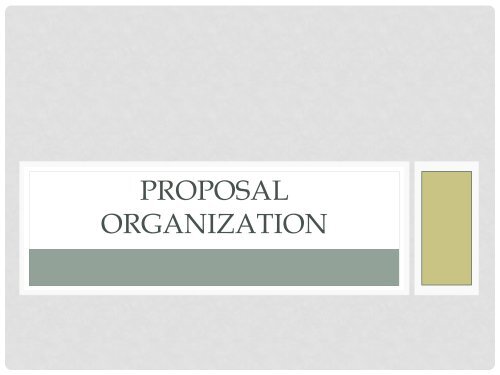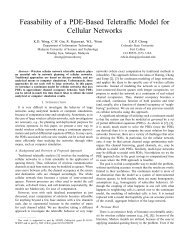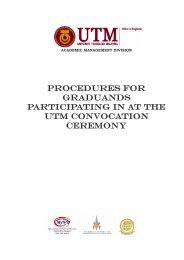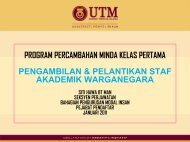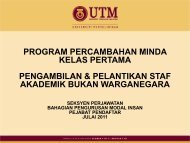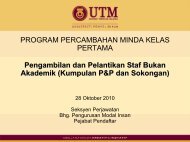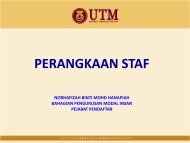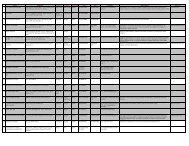comprehensive master plan - UTM
comprehensive master plan - UTM
comprehensive master plan - UTM
You also want an ePaper? Increase the reach of your titles
YUMPU automatically turns print PDFs into web optimized ePapers that Google loves.
PROPOSAL<br />
ORGANIZATION
LIST OF PROPOSAL SECTIONS<br />
Proposal Section<br />
TITLE Writing Hints Example<br />
PROJECT OVERVIEW Writing Hints Example<br />
BACKGROUND<br />
INFORMATION/<br />
STATEMENT OF THE<br />
PROBLEM<br />
PROJECT DETAIL<br />
Writing Hints Example<br />
- Goals & Objectives Writing Hints Example<br />
- Clientele Writing Hints Example<br />
- Methods Writing Hints Example<br />
- Staff/Administration Writing Hints Example<br />
AVAILABLE RESOURCES Writing Hints Example<br />
NEEDED RESOURCES<br />
- Personnel Writing Hints Example<br />
- Facilities Writing Hints Example<br />
-<br />
Equipment/Supplies/Co<br />
mmunication<br />
Writing Hints Example<br />
- Budget Writing Hints Example<br />
EVALUATION PLAN Writing Hints Example<br />
APPENDICES Writing Hints Example
TITLE<br />
• The title should be clear and unambiguous (do not make it "cute").<br />
• Think of your title as a mini-abstract. A good title should paint a quick picture for the reader of the key idea(s) of your project.<br />
• The words you use in your title should clearly reflect the focus of your proposal. The most important words should come first,<br />
then the less important words. Notice that both of the following titles use basically the same words, except in a different<br />
order. The project with Title #1 appears to be focused on Red Haired Musicians. The project with Title #2 appears to be<br />
focused on Musical Style Preference. However, both projects are the same! Make sure your words are in the correct order.<br />
• Title #1 - Red Haired Musicians and their Preference for Musical Style<br />
• Title #2 - Music Style Preference of Red Haired Musicians<br />
• Try to remove words from your title that really are not necessary for understanding. Title #1 has too many words. Title #2 is just<br />
as clear but with fewer words.<br />
• Title #1 - The Systematic Development of a Local Initiative to Create a Learning Center for Community Education<br />
• Title #2 - A Local Learning Center for Community Education<br />
• Try and use only a single sentence for your title. If the sentence is getting too long try removing some words. When all else fails<br />
try using a two part title with the parts separated by a colon (use only as a last resort!). Do not attempt to use the title as an<br />
abstract of your entire proposal.
PROJECT OVERVIEW<br />
• Think of the Project Overview as an Executive Summary (the busy executive<br />
probably only has enough time to read your Overview - not the entire proposal). Be<br />
specific and concise. Do not go into detail on aspects of your proposal that are<br />
further clarified at a later point in your proposal.<br />
• The Project Overview should "paint a picture" of your proposal in the mind of the<br />
reader. It should establish the framework so that the rest of the proposal has a<br />
frame of reference.<br />
• Use the Project Overview to begin to show your knowledge of the organization<br />
from which you are requesting funds. Key concerns of the funding organization can<br />
be briefly identified in relation to your proposed project.<br />
• If you will be collaborating with other organizations make sure some of their<br />
interests are also highlighted in the Project Overview. This can assist in strengthening<br />
the collaboration by recognizing them at the very beginning of your proposal.<br />
• The best time to prepare the Project Overview is after you have completed the<br />
entire proposal (and you understand all aspects of your proposal very well). Let the<br />
Overview be your last piece of writing and then insert it at the beginning of your<br />
proposal.
DO NOT WANT THESE COMMENTS<br />
• Try to keep in mind that someone will be reviewing your<br />
proposal and you would like to have this person be very<br />
positive about what you have written. The Project Overview<br />
will probably form a strong impression in the mind of the<br />
reviewer. Work on your Project Overview so that you can<br />
avoid giving this person the opportunity to say things like:<br />
• Not an original idea<br />
• Rationale is weak<br />
• Writing is vague<br />
• Uncertain outcomes<br />
• Does not have relevant experience<br />
• Problem is not important<br />
• Proposal is unfocused<br />
• Project is too large.
EXAMPLE<br />
While nanotechnology is an industry driven by research and development, it is also one that is<br />
limited by the availability of a technical workforce. In order to meet future workforce demands, the Tech Valley<br />
region must respond quickly to establish efficient and effective training initiatives:<br />
� To stimulate the technical vitality of the current workforce;<br />
� To deliver a future pool of skilled technicians, and;<br />
� To continue to attract high technology business enterprises to this region through ready access to a<br />
skilled workforce.<br />
In response to this demand, Hudson Valley Community College (HVCC), geographically located<br />
at the center of Tech Valley and the Capital Region, proposes to develop a <strong>plan</strong> to establish the Tech Valley<br />
ATE Center for Semiconductor and Nanotechnology Workforce Development. This <strong>plan</strong>ning project will<br />
engage a partnership from among education, industry, and government resources to design a Center that will<br />
offer semiconductor and nanotechnology-related associate’s degree programs, on-the-job training, distance<br />
learning options, just-in-time training, and K-12 pipeline development programs. The Center itself will be<br />
based at HVCC with industry, government, and education partners including two leading NSF-sponsored ATE<br />
Centers, Maricopa Advanced Technology Education Center (MATEC) and the National Center for<br />
Telecommunications Technologies (NCTT), GE Global Research, International SEMATECH North, University<br />
at Albany College of Nanoscale Science and Engineering, Rensselaer Polytechnic Institute, Rochester<br />
Institute of Technology, Saratoga High School, Albany High School, Troy High School, Excelsior College, and<br />
several other of Hudson Valley’s sister institutions within the State University of New York system such as<br />
Mohawk Valley Community College, College of Technology at Alfred, SUNY Institute of Technology, and<br />
Empire State College. The Center will work to leverage the multi-faceted resources of academia, industry,<br />
government and other ATE centers to anticipate and fulfill the workforce education and training needs of the<br />
semiconductor and nanotechnology industries in Tech Valley, as well as throughout New York State and the<br />
Northeast region.
EXAMPLE<br />
A community-based mothers and infants center called "Healthy Moms for Healthy Kids" (Pusat Ibu<br />
dan Anak Sihat or PIAS) will be established in Kota Emessu, the city surrounding the Universitas<br />
Pembangunan Pertanian (UNPEMPER). PIAS will focus on providing nutritional education and<br />
counseling for mothers, especially those from the extremely low income areas. It is expected that<br />
through the providing of information to the mothers that it will be possible to have a direct and<br />
positive effect on the well being of the young children of the community.<br />
PIAS will utilize volunteers who are students at UNPEMPER. Each student will be expected to<br />
successfully participate in a 4 week training program at the beginning of their work with PIAS. This<br />
training program will provide basic nutritional information for mothers and information on adult<br />
teaching methods. Student volunteers who demonstrate proficiency during the initial training<br />
program will be invited to participate in an advanced training program to learn effective<br />
nutritional counseling techniques. Each student volunteer will be expected to contribute 3-5 hours<br />
each week and to continue with PIAS for a period of not less than 6 months.<br />
PIAS will operate with 6 full and part time staff members. In addition, a Governing Board made up<br />
of community leaders and university staff will operate to provide overall sanctioning of the Center's<br />
operation. Periodic evaluations will be conducted to assess the value of PIAS on a) helping the<br />
student volunteers to become effective educators, b) the development of new understandings on<br />
the part of local mothers and c) the improvement of the well being of children in Kota Emessu.
BACKGROUND/PROBLEM STATEMENT<br />
It may be easier to think of this section as a review of Relevant Literature." Cite previous projects<br />
and studies that are similar to what you are proposing. Show the funding agency that you know<br />
what you are proposing because you are familiar with what has preceded you.<br />
Try to be careful in your use of language. It can very helpful to have a friend, outside of your area<br />
of focus/expertise, read your proposal to make sure that the language is readable and minimizes<br />
the use of:<br />
jargon<br />
trendy or "in" words<br />
abbreviations<br />
colloquial expressions<br />
redundant phrases<br />
confusing language<br />
Position your project in relation to other efforts and show how your project:<br />
a) will extend the work that has been previously done,<br />
b) will avoid the mistakes and/or errors that have been previously made,<br />
c) will serve to develop stronger collaboration between existing initiatives, or<br />
d) is unique since it does not follow the same path as previously followed.
BACKGROUND/PROBLEM STATEMENT<br />
It is essential to include a well documented statement of the need/problem that is the<br />
basis for your project. What are the pressing problems that you want to address? How<br />
do you know these problems are important? What other sources/programs similarly<br />
support these needs as major needs?<br />
Check to see that the potential funding agency is committed to the same<br />
needs/problems that your proposal addresses. Clearly indicate how the problems<br />
that will be addressed in your project will help the potential funding agency in fulfilling<br />
their own goals and objectives. As you write, keep the funding agency in your mind<br />
as a "cooperating partner" committed to the same concerns that you are.<br />
Is there a special reason why you and/or your organization are uniquely suited to<br />
conduct the project? (Geographic location, language expertise, prior involvements<br />
in this area, close relationship to the project clientele, etc.)<br />
When you get to the Methods Section of your proposal it will be important to refer<br />
back to the needs you've identified in this section (and show how your methods will<br />
respond to these needs).
EXAMPLE<br />
Major obstacles to child survival in the developing world include infections, parasitic diseases,<br />
malnutrition and the risks associated with low birth weight and high fertility. (UN Informational Letter<br />
#37-435) A serious problem exists in the rural villages of Malnesia of children dying from common<br />
illness and infections that are attributable to poor nutrition. Though high nutrition foods are<br />
available in the villages, it is apparent that mothers do not have an understanding of exactly what<br />
foods contain the most value for their children. (Ministry of Health, 1994) The most significant person<br />
in the life of the young child is the child's mother. Research has shown that the children of mothers<br />
who have an understanding of how to provide good nutrition to their children stand a significantly<br />
greater chance of survival during the first three years of life (87% survival rate) as compared with<br />
children of mothers who do not know how to provide good nutrition (43% survival rate) (Position<br />
Paper, Opening Plenary Session, Malnesian Health Conference - MALHEALTHCON - 96).<br />
The use of volunteers to provide community service is a new concept in Malnesia and can be<br />
capitalized upon as a viable way to provide trained manpower for the offering of educational<br />
services. The first student service scheme, Service Mahasiswa/SERMAH, was created in the early<br />
1990s. Initially operated at only two universities, SERMAH is now a mandated national program that<br />
operates at all public and private universities (Directorate for Higher Education, Ministry of<br />
Education, Statistics for 1996). The emphasis of SERMAH has been exclusively on the providing of<br />
information to local farmers on improved farming practices. The Universitas Pembangunan<br />
Pertanian has been funded by the Ministry of Agriculture to operate the SERMAH Educational<br />
Development Center (Introducing SERMAH, Ministry of Agriculture, 1996) as a central agency for<br />
the providing of farming practices instructional materials to all universities in Malnesia. The selection<br />
and training of student volunteers is conducted autonomously at each university with the support<br />
of the instructional materials disseminated by the SERMAH Educational Development Center.
GOALS , OBJECTIVES, OUTCOMES<br />
Try and differentiate between your goals and your objectives - and include both.<br />
Goals are the large statements of what you hope to accomplish but usually aren't very<br />
measurable. They create the setting for what you are proposing.<br />
Objectives are operational, tell specific things you will be accomplishing in your project, and are<br />
very measurable.<br />
Your objectives will form the basis for the activities of your project and will also serve as the basis for<br />
the evaluation of your project.<br />
Try to insure that there is considerable overlap between the goals and objectives for your proposal<br />
and the goals and objectives of the funding organization. If there is not a strong overlap of goals<br />
and objectives then it might be best to identify a different funding organization.<br />
Present measurable objectives for your project. If you are dealing with "things" it is easier for them to<br />
be measured than if you are dealing with abstract ideas. Your proposal is easier for a prospective<br />
funding organization to understand (and the outcomes are much more clear) if you describe your<br />
objectives in measurable ways.<br />
•
EXAMPLE OF GOAL<br />
The long-term goal of this <strong>plan</strong>ning proposal will be to establish the Tech<br />
Valley ATE Center for Semiconductor and Nanotechnology Workforce<br />
Development, led by Hudson Valley Community College, whose mission<br />
will be to bring together business, educators, and government in a<br />
collaborative effort to build a highly-skilled technical workforce to meet the<br />
soon-to-be burgeoning employment demands of these rapidly growing<br />
industries in our region. When fully implemented, this Center will deliver<br />
cutting-edge educational and training programs, coordinate student<br />
recruitment and cooperative employment opportunities, research emerging<br />
workforce trends and training needs, and disseminate findings and best<br />
practices for the benefit of its partners, the regional economy as a whole,<br />
and other communities seeking answers for similar challenges.<br />
• To achieve this, the college must first undergo an intensive<br />
<strong>plan</strong>ning process culminating in a well-researched, inclusive, and<br />
<strong>comprehensive</strong> <strong>master</strong> <strong>plan</strong> to implement a Tech Valley ATE Center for<br />
Semiconductor and Nanotechnology Workforce Development. This<br />
intensive <strong>plan</strong>ning process will be accomplished through attainment of the<br />
following objectives:
EXAMPLE OF OBJECTIVES<br />
Objective 1<br />
Objective 2<br />
Objective 3<br />
Objective 4<br />
Objective 5<br />
Objective 6<br />
Identify and formalize alliances with regional business, industry,<br />
educational, and government entities whose partnership will be<br />
critical to the development of a successful <strong>plan</strong> for a regional<br />
center.<br />
Identify skills necessary for the emerging workforce in the Tech<br />
Valley region.<br />
Develop an ongoing faculty professional development <strong>plan</strong> that<br />
includes strategies and activities to ensure skilled and<br />
knowledgeable faculty able to keep pace with emerging industry<br />
standards.<br />
Develop a pipeline transfer <strong>plan</strong> that will seamlessly facilitate<br />
student transition from high school to 2-year to 4-year<br />
postsecondary institutions.<br />
Define a career track with clear educational goals and benchmarks<br />
that aligns itself with workforce demands in the targeted industry<br />
sectors.<br />
Develop a <strong>comprehensive</strong> strategic <strong>plan</strong> for the implementation of<br />
an ATE Regional Center.
CLIENTELE<br />
Include specific information on the population or clientele that your project is focused on.<br />
Exactly who are the clientele? Who is included in the clientele group?<br />
In what ways have you already had contact with the clientele group?<br />
Can you show that you have the support of the clientele group to move ahead with the project?<br />
In what ways have members of the clientele group been involved in the preparation of the<br />
proposal?<br />
What other agencies are involved with this clientele group (and have these other agencies been<br />
included in your proposed project)?<br />
It's important for the funding agency to see how much the clientele group has been involved with<br />
the project and the preparation of the proposal. (Sometimes a project is funded and then the<br />
director finds that the clientele group does not want to be involved!! Don't let that happen to you.)<br />
Be sure to clarify why it is important for the funding organization to be concerned about your<br />
clientele. Your proposal should clearly indicate how assisting your clientele is in the best interests of<br />
the funding organization.
EXAMPLE<br />
There are two different clientele groups for this project.<br />
The first, and primary, clientele are the mothers of young<br />
children who live in Kota Emessu. This clientele group is<br />
represented in the project objectives for Goal #1.<br />
The second clientele group are the students at Universitas<br />
Pembangunan Pertanian who will participate in the Project as<br />
volunteers. This clientele group is represented in the project<br />
objectives for Goal #2.<br />
Both clientele groups are important and essential components<br />
of this project. It is expected that significant learning will take<br />
place for both clientele groups.
DELIVERABLES AND METHODS<br />
There should be a very clear link between the methods you describe in this section<br />
and the objectives you have previously defined. Be explicit in your writing and state<br />
exactly how the methods you have chosen will fulfill your project's objectives and<br />
help deal with the needs/problems on which your proposal is focused.<br />
The prospective funding agency will be looking at your methods to see what it is that<br />
you are proposing that will be new, unique or innovative. Make sure you clearly<br />
present the innovative aspects of your idea.<br />
Are the specific methods you are proposing for your project very important to your<br />
unique clientele? Make sure you clarify this for the funding organization.<br />
Do not forget to include the collaborative relationships your project will be<br />
developing with other cooperating groups. A good way to show collaboration is in<br />
the methods that you will be using. How will the methods for your project encourage<br />
groups to join together in dealing with the issues/concerns your project addresses?<br />
Your Methods section should clearly indicate how the methods that will be used will<br />
allow the outcomes of your project to have value for others beyond your project. (This<br />
can also tie into your Dissemination Plan - see the Appendices section for more hints<br />
on dissemination.)
EXAMPLE OF DELIVERABLES<br />
• Comprehensive strategic <strong>plan</strong> to implement and<br />
establish an ATE Regional Center for Semiconductor<br />
and Nanotechnology Workforce Development<br />
• Career track technical educational program for the<br />
semiconductor and nanotechnology industries<br />
• Faculty professional development <strong>plan</strong> to keep<br />
pace with emerging industry needs<br />
• Pipeline transfer technical track <strong>plan</strong> for seamless<br />
transition in a 2+2+2 articulated path
EXAMPLE OF ACTIVITIES/METHODS<br />
ACTIVITY TASKS PROJECTED OUTCOMES<br />
Activity 1: The<br />
PI, Planning<br />
Committee and<br />
project staff will<br />
research<br />
operational models<br />
of ATE Centers.<br />
This activity<br />
supports<br />
Objectives 1, 2, 3,<br />
4, 5, and 6.<br />
Activity 2:<br />
Develop a process<br />
to identify<br />
semiconductor and<br />
nanotechnology<br />
industry skill needs<br />
for the Tech Valley<br />
region. This<br />
activity supports<br />
Objectives 2, 3, 4,<br />
and 5.<br />
� Attend MATEC’s SAME-TEC<br />
annual conference in Austin,<br />
TX, July 2008<br />
� Conduct site visit to NCTT,<br />
Springfield MA<br />
� Communicate with and research<br />
additional centers to study their<br />
organization, structure, history<br />
of development, products and<br />
services, etc.<br />
� Identify existing best practices<br />
and exemplary curricula that<br />
support the specified industries<br />
working with MATEC experts<br />
and other NSFATE sources.<br />
� Study existing skill set<br />
standards developed by<br />
MATEC for Semiconductor<br />
Equipment Technicians and<br />
Technicians Working in Highly<br />
Automated Manufacturing<br />
Environments<br />
� Consult with colleague experts<br />
at MATEC, NCTT, and other<br />
ATE center colleagues on<br />
effective processes to<br />
customize existing standards in<br />
order to adapt them for Tech<br />
Valley’s regional needs.<br />
� Consult with colleague experts<br />
at MATEC, NCTT, and other<br />
ATE center colleagues on<br />
effective <strong>plan</strong>ning processes to<br />
apply to identify new and<br />
emerging standards for future<br />
growth of the program.<br />
Comprehensive design for<br />
the structure of a regional<br />
ATE Center for<br />
semiconductor and<br />
nanotech workforce<br />
development in the Tech<br />
Valley region, based on<br />
this study of best practices,<br />
field research and<br />
consultation with expert<br />
colleagues from existing<br />
NSF ATE Centers.<br />
National skill set standards<br />
from MATEC will be<br />
aligned with identified<br />
current and projected<br />
regional workforce needs<br />
and demands in<br />
semiconductor<br />
manufacturing technology<br />
and nanotechnology.
EXAMPLE OF TIMELINE<br />
Activity Spring<br />
08<br />
1. Research operational models of ATE<br />
Centers<br />
2. Develop a process to identify industry<br />
skill needs<br />
3. Participate in MATEC’s SAME-TEC<br />
Conference<br />
4. Planning Summit w/industry,<br />
government and education<br />
5. Half-day workshop for secondary and<br />
postsecondary educators<br />
6. Develop strategic business <strong>plan</strong> for<br />
ATE Center<br />
Summer<br />
08<br />
Fall 08 Spring<br />
09
PROJECT ADMINISTRATION<br />
Use this section to describe the roles of the different people associated with<br />
your project and the importance of each.<br />
Make sure to clarify how each of the roles are essential to the success of<br />
the project and each role clearly relates to operationalizing the methods<br />
you have described.<br />
So what do you say about your key people? To start, make sure you include<br />
name, title, experience, and qualifications. Include other information if you<br />
feel it's important to the success of your project.<br />
The descriptions of your personnel should let the funding agency know that<br />
you have excellent people who are committed to the project. You are not<br />
asking the funding agency to "trust" you. The validity for what you are<br />
proposing is directly related to the people who will work with the project.<br />
Working together as a part of a team is something that funding agencies<br />
often like to see. Try making your project a team effort.
EXAMPLE<br />
• The Project will employ three full-time and three part time staff.<br />
• Project Director (full time)- Responsible for hiring project staff, overseeing project development and operation,<br />
establishing and maintaining links with local government agencies, and budget. The Project Director will be<br />
Harjono Soemadji (author of this proposal).<br />
• Center Coordinator (full time)- Responsible for establishing the community Center, developing working<br />
relationships with formal and informal community leaders, establishing links to community women's organizations,<br />
and scheduling of Center programs.<br />
• Volunteer Coordinator (full time)- Responsible for recruiting university student volunteers, establishing and<br />
maintaining a working linkage with the UNPEMPER Department of Food and Nutrition, developing and offering<br />
training programs for volunteers, scheduling volunteers for service at the Center. The Volunteer Coordinator will<br />
have a background in food and nutrition and will be housed in the Department of Food and Nutrition.<br />
• Project Evaluator (part time) - Responsible for collecting entry level data regarding mother's health and nutrition<br />
information and conducting periodic assessment of changes in their level of knowledge, comprehension, and<br />
application of that information. Also responsible for developing and implementing a system for periodic formative<br />
evaluation of the work of the student volunteers.<br />
• Center Assistant (part time) - Responsible for maintaining the structure and appearance of the Center, routine<br />
correspondence, and other forms of communication with mothers in the community.
AVAILABLE RESOURCES<br />
Collaborative efforts (an important project resource) are usually considered very<br />
favorably! Many funding agencies like to see cooperative ventures as the basis for<br />
local action. In other words, the funding agency's dollars are being brought together<br />
with other existing organizations that are already committed and involved in dealing<br />
with the needs that the project is responding to.<br />
Sometimes local resources go unnoticed and are difficult to see. Look carefully<br />
around you because there are certain to be resources that you have available that<br />
you may not be noticing (time that volunteers donate to your project, materials that<br />
local merchants may provide, local experts who can provide help/advise when<br />
needed, a friend who is willing to do some word processing, etc.). Such in-kind<br />
resources can show a potential funding agency that you are strongly rooted in your<br />
community.<br />
It is very impressive to a prospective funding agency if local resources have already<br />
been contacted and <strong>plan</strong>s to include them in the project have already been made.<br />
Letters from local resources supporting the project (included in the Appendix) are an<br />
excellent addition to the proposal.
EXAMPLE<br />
The college is one of 30 community colleges among the 64 campuses of the State University of<br />
New York (SUNY) and maintains a campus of 18 buildings with over 1,000,000 sq. ft. of space on 120<br />
acres. Fall 2007 enrollment is 12,300. HVCC is accredited by the Commission on Higher Education<br />
and a member of the Middle States Association of Colleges and Schools. Its 73 degree and<br />
certificate programs are registered and approved by the New York State Department of<br />
Education, with the authority to award associate degrees in arts, science, applied science,<br />
occupational studies, and occupation-specific certificates. Over 40% of our students receive some<br />
form of financial aid. Each year, 92% of our graduates go on to employment in their field or<br />
transfer to a four-year institution.<br />
In 2005, the college introduced an associate’s degree program in Semiconductor<br />
Manufacturing Technology to respond to the growing demand for skilled technicians in this field.<br />
This program provides education for employment and transfer through a competency-based<br />
curriculum, with hands-on instruction that supports developments in the semiconductor industry,<br />
including present and emerging fields such as semiconductor fabrication, microelectromechanical<br />
systems, and nanotechnology. Courses take a mathematical approach, with<br />
both theory and laboratory components. Through an agreement with the University at Albany,<br />
students perform lab experiments for Semiconductor Manufacturing and Metrology at the<br />
University at Albany College of Nanoscale Science and Engineering (CNSE) facilities, one of the<br />
best college cleanrooms in the nation. In 2005, HVCC was awarded a five-year Strengthening<br />
Institutions Title III grant from the US Department of Education that included funds for a new<br />
semiconductor manufacturing technology lab. Construction of the new lab began Summer 2007.
NEEDED RESOURCES ( PERSONNEL )<br />
Refer back to your Staff/Administration section and identify those people<br />
who will actually be paid from the grant - these are the ones to be<br />
identified in this section<br />
Include short descriptions of each of the people who will be involved in<br />
your project and supported by the funding. The descriptions should clarify in<br />
the mind of the potential funding agency that these people are ideally<br />
suited to conduct the project.<br />
Instead of having all full-time staff on the project, consider having a number<br />
of part-time staff - especially if the part-time staff currently work with other<br />
cooperating organizations. This is a good way to show inter-agency<br />
collaboration.<br />
Make sure you notify people who you identify in your Personnel section and<br />
receive their approval before you send in your proposal.
NEEDED RESOURCES ( FACILITIES )<br />
Though you may not be requesting funds for the<br />
purchase or rental of facilities, it can be helpful to<br />
provide a brief description of the facilities that will be<br />
used for the project.<br />
Consider describing existing facilities that will be used<br />
for the project as in-kind contributions to the project
NEEDED RESOURCES ( EQUIPMENT )<br />
It will help if you've really done some research on the<br />
actual cost of the equipment you specify. This is<br />
much better than "guessing" at the cost and then to<br />
be challenged on your estimates by the potential<br />
funding agency.
BUDGET<br />
Make your budget realistic. Carefully think through exactly what you will need from<br />
the funding agency to carry out the project and establish your budget around this<br />
amount. (Do not forget, funding agencies receive lots of requests for funding. They<br />
can easily tell when someone has inflated a budget in order to procure funds for<br />
other purposes. Don't get caught in this situation.)<br />
Do you really need a large amount of funding at the beginning of the project or will<br />
your project be "phased up" over a period of time? Sometimes it's not very realistic to<br />
expect a new project to be able to be up and operating (and spending large<br />
amounts of money) during the first 6 months or year of operation.<br />
A good strategy to use with a potential funding agency is to ask for a small amount of<br />
funding for the first phase of the project. Specify in your proposal what you expect to<br />
achieve during this "minimal funding phase" and when you will be returning to the<br />
funding agency to ask for funds for the next phase. This can suggest to the funding<br />
agency that they can terminate the relationship easily if your project is not successful<br />
(and then it is essential for you to make sure the first phase IS successful).
EVALUATION PLAN<br />
It's important to describe in your proposal exactly how you will decide whether or not your project has been successful, achieved<br />
its objectives, etc. The Evaluation Plan will tell the prospective funding agency how you will be going about showing them at the<br />
end of the project that their investment in you was a good one.<br />
If you <strong>plan</strong> to use a survey or questionnaire to help in evaluating the success of your project you may want to include in the<br />
Appendices a draft of what you are considering for the questionnaire/survey.<br />
Your evaluation <strong>plan</strong> does not have to be elaborate but it is important to indicate to the prospective funding agency that you have<br />
not forgotten this important step.<br />
Try to include both a concern for formative evaluation/process evaluation (ways to gain feedback on the project while it is being<br />
conducted) and summative evaluation/product evaluation (ways to show that the project fulfilled that which was originally<br />
proposed). Another way of conceptualizing this is that formative evaluation/process evaluation is concerned with the activities of<br />
the project. On the other hand, summative evaluation/product evaluation is concerned with the stated objectives of the project.<br />
It is easy to create a summative evaluation/product evaluation <strong>plan</strong> if you have done a good job of clearly stating your project<br />
objectives or expected outcomes.<br />
Make direct reference to your objectives in your evaluation <strong>plan</strong>. This creates a strong sense of integration/consistency within<br />
your proposal. The reader of your proposal will now be hearing the same message repeated in different sections of your<br />
proposal.<br />
Try creating two separate evaluation <strong>plan</strong>s - one for formative evaluation and the other for summative evaluation.<br />
A good evaluation <strong>plan</strong> should include some sense of concern for what goes on following the conclusion of the funding period.<br />
How will the initiatives that have been started under the project be sustained? Have new things occurred that will be continued in<br />
the future? How will other cooperating agencies assist in continuing the project after the conclusion of the funding period? These<br />
and other areas should be included in a viable evaluation <strong>plan</strong>.
EXAMPLE<br />
For the purpose of this evaluation, a mixed-method approach will be<br />
utilized. This mixed-method approach will incorporate both formative and<br />
summative evaluation activities and provide “data evidence loops” back<br />
to project directors and other related staff/faculty.<br />
Evaluation Activity #1: To Document Project’s Ability to Develop Necessary<br />
Capacity. For the purpose of this evaluation activity, the evaluator will work<br />
to document that the initial activities have been conducted and that the<br />
necessary capacity to implement the project is in place. This will include,<br />
but not limited to, documenting that the appropriate staff members have<br />
been hired, documenting that the anticipated partners (e.g. high schools,<br />
industry, institutions of higher education) are in place, and documenting<br />
that the information/workshop training sessions promised as a deliverable<br />
have indeed occurred. Data for this evaluation objective will be collected<br />
through multiple sources; these sources include but are not limited to,<br />
project records, invoices, review of project’s budget, and training materials<br />
etc. This data will be collected through the use of a criterion-based<br />
evaluation instrument that will be developed by the evaluator and used as<br />
a working document to guide project directors and program staff. This<br />
evaluation activity will address Program Objective #1.
DISSEMINATION PLAN<br />
The activities and outcomes of this project will be<br />
communicated through several venues to reach as wide a<br />
constituency as possible:<br />
• A website will be created as part of the college website to<br />
provide information and updates on the project’s events, activities,<br />
and outcomes.<br />
• HVCC’s Community Relations Department will support the<br />
project with press releases and additional media coverage<br />
highlighting this NSF project.<br />
• Information on project results will also be disseminated, via<br />
publications, participation in conferences, through targeted<br />
educational and industry organizations such as MATEC, NETEC<br />
(through NJCATE) and other NSF-ATE dissemination opportunities.


